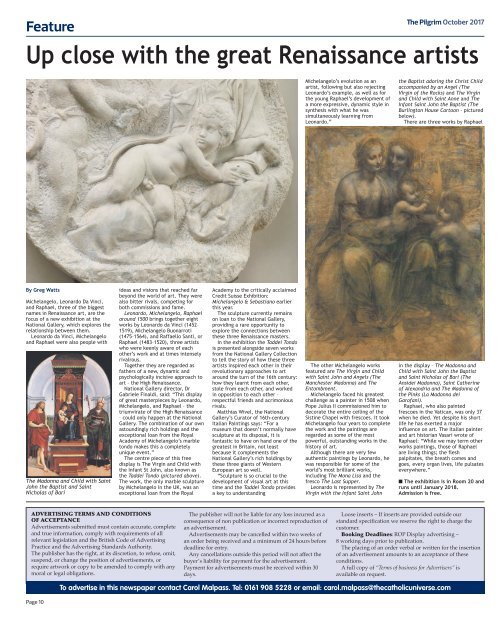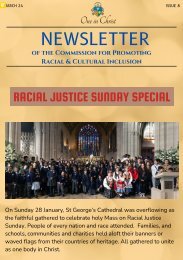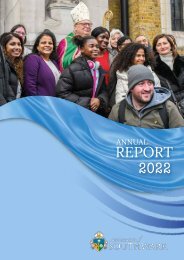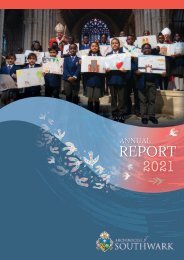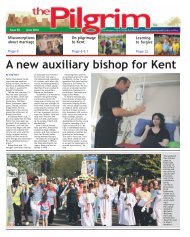Issue 65 - The Pilgrim - October 2017 - The newspaper of the Archdiocese of Southwark
The October 2017 issue of "The Pilgrim", the newspaper of the Archdiocese of Southwark
The October 2017 issue of "The Pilgrim", the newspaper of the Archdiocese of Southwark
Create successful ePaper yourself
Turn your PDF publications into a flip-book with our unique Google optimized e-Paper software.
Feature<br />
<strong>The</strong> <strong>Pilgrim</strong> <strong>October</strong> <strong>2017</strong><br />
Up close with <strong>the</strong> great Renaissance artists<br />
Michelangelo’s evolution as an<br />
artist, following but also rejecting<br />
Leonardo’s example, as well as for<br />
<strong>the</strong> young Raphael’s development <strong>of</strong><br />
a more expressive, dynamic style in<br />
syn<strong>the</strong>sis with what he was<br />
simultaneously learning from<br />
Leonardo.”<br />
<strong>the</strong> Baptist adoring <strong>the</strong> Christ Child<br />
accompanied by an Angel (<strong>The</strong><br />
Virgin <strong>of</strong> <strong>the</strong> Rocks) and <strong>The</strong> Virgin<br />
and Child with Saint Anne and <strong>The</strong><br />
Infant Saint John <strong>the</strong> Baptist (<strong>The</strong><br />
Burlington House Cartoon - pictured<br />
below).<br />
<strong>The</strong>re are three works by Raphael<br />
By Greg Watts<br />
Michelangelo, Leonardo Da Vinci,<br />
and Raphael, three <strong>of</strong> <strong>the</strong> biggest<br />
names in Renaissance art, are <strong>the</strong><br />
focus <strong>of</strong> a new exhibition at <strong>the</strong><br />
National Gallery, which explores <strong>the</strong><br />
relationship between <strong>the</strong>m.<br />
Leonardo da Vinci, Michelangelo<br />
and Raphael were also people with<br />
<strong>The</strong> Madonna and Child with Saint<br />
John <strong>the</strong> Baptist and Saint<br />
Nicholas <strong>of</strong> Bari<br />
ideas and visions that reached far<br />
beyond <strong>the</strong> world <strong>of</strong> art. <strong>The</strong>y were<br />
also bitter rivals, competing for<br />
both commissions and fame.<br />
Leonardo, Michelangelo, Raphael<br />
around 1500 brings toge<strong>the</strong>r eight<br />
works by Leonardo da Vinci (1452–<br />
1519), Michelangelo Buonarroti<br />
(1475–1564), and Raffaello Santi, or<br />
Raphael (1483–1520), three artists<br />
who were keenly aware <strong>of</strong> each<br />
o<strong>the</strong>r’s work and at times intensely<br />
rivalrous.<br />
Toge<strong>the</strong>r <strong>the</strong>y are regarded as<br />
fa<strong>the</strong>rs <strong>of</strong> a new, dynamic and<br />
psychologically incisive approach to<br />
art – <strong>the</strong> High Renaissance.<br />
National Gallery director, Dr<br />
Gabriele Finaldi, said: “This display<br />
<strong>of</strong> great masterpieces by Leonardo,<br />
Michelangelo, and Raphael – <strong>the</strong><br />
triumvirate <strong>of</strong> <strong>the</strong> High Renaissance<br />
– could only happen at <strong>the</strong> National<br />
Gallery. <strong>The</strong> combination <strong>of</strong> our own<br />
astoundingly rich holdings and <strong>the</strong><br />
exceptional loan from <strong>the</strong> Royal<br />
Academy <strong>of</strong> Michelangelo’s marble<br />
tondo makes this a completely<br />
unique event.”<br />
<strong>The</strong> centre piece <strong>of</strong> this free<br />
display is <strong>The</strong> Virgin and Child with<br />
<strong>the</strong> Infant St John, also known as<br />
<strong>the</strong> Taddei Tondo (pictured above).<br />
<strong>The</strong> work, <strong>the</strong> only marble sculpture<br />
by Michelangelo in <strong>the</strong> UK, was an<br />
exceptional loan from <strong>the</strong> Royal<br />
Academy to <strong>the</strong> critically acclaimed<br />
Credit Suisse Exhibition:<br />
Michelangelo & Sebastiano earlier<br />
this year.<br />
<strong>The</strong> sculpture currently remains<br />
on loan to <strong>the</strong> National Gallery,<br />
providing a rare opportunity to<br />
explore <strong>the</strong> connections between<br />
<strong>the</strong>se three Renaissance masters.<br />
In <strong>the</strong> exhibition <strong>the</strong> Taddei Tondo<br />
is presented alongside seven works<br />
from <strong>the</strong> National Gallery Collection<br />
to tell <strong>the</strong> story <strong>of</strong> how <strong>the</strong>se three<br />
artists inspired each o<strong>the</strong>r in <strong>the</strong>ir<br />
revolutionary approaches to art<br />
around <strong>the</strong> turn <strong>of</strong> <strong>the</strong> 16th century:<br />
how <strong>the</strong>y learnt from each o<strong>the</strong>r,<br />
stole from each o<strong>the</strong>r, and worked<br />
in opposition to each o<strong>the</strong>r –<br />
respectful friends and acrimonious<br />
rivals.<br />
Matthias Wivel, <strong>the</strong> National<br />
Gallery’s Curator <strong>of</strong> 16th-century<br />
Italian Paintings says: “For a<br />
museum that doesn’t normally have<br />
sculpture at its disposal, it is<br />
fantastic to have on hand one <strong>of</strong> <strong>the</strong><br />
greatest in Britain, not least<br />
because it complements <strong>the</strong><br />
National Gallery’s rich holdings by<br />
<strong>the</strong>se three giants <strong>of</strong> Western<br />
European art so well.<br />
“Sculpture is so crucial to <strong>the</strong><br />
development <strong>of</strong> visual art at this<br />
time and <strong>the</strong> Taddei Tondo provides<br />
a key to understanding<br />
<strong>The</strong> o<strong>the</strong>r Michelangelo works<br />
featured are <strong>The</strong> Virgin and Child<br />
with Saint John and Angels (<strong>The</strong><br />
Manchester Madonna) and <strong>The</strong><br />
Entombment.<br />
Michelangelo faced his greatest<br />
challenge as a painter in 1508 when<br />
Pope Julius II commissioned him to<br />
decorate <strong>the</strong> entire ceiling <strong>of</strong> <strong>the</strong><br />
Sistine Chapel with frescoes. It took<br />
Michelangelo four years to complete<br />
<strong>the</strong> work and <strong>the</strong> paintings are<br />
regarded as some <strong>of</strong> <strong>the</strong> most<br />
powerful, outstanding works in <strong>the</strong><br />
history <strong>of</strong> art.<br />
Although <strong>the</strong>re are very few<br />
au<strong>the</strong>ntic paintings by Leonardo, he<br />
was responsible for some <strong>of</strong> <strong>the</strong><br />
world’s most brilliant works,<br />
including <strong>The</strong> Mona Lisa and <strong>the</strong><br />
fresco <strong>The</strong> Last Supper.<br />
Leonardo is represented by <strong>The</strong><br />
Virgin with <strong>the</strong> Infant Saint John<br />
in <strong>the</strong> display – <strong>The</strong> Madonna and<br />
Child with Saint John <strong>the</strong> Baptist<br />
and Saint Nicholas <strong>of</strong> Bari (<strong>The</strong><br />
Ansidei Madonna), Saint Ca<strong>the</strong>rine<br />
<strong>of</strong> Alexandria and <strong>The</strong> Madonna <strong>of</strong><br />
<strong>the</strong> Pinks (La Madonna dei<br />
Gar<strong>of</strong>ani).<br />
Raphael, who also painted<br />
frescoes in <strong>the</strong> Vatican, was only 37<br />
when he died. Yet despite his short<br />
life he has exerted a major<br />
influence on art. <strong>The</strong> Italian painter<br />
and art historian Vasari wrote <strong>of</strong><br />
Raphael: “While we may term o<strong>the</strong>r<br />
works paintings, those <strong>of</strong> Raphael<br />
are living things; <strong>the</strong> flesh<br />
palpitates, <strong>the</strong> breath comes and<br />
goes, every organ lives, life pulsates<br />
everywhere.”<br />
n <strong>The</strong> exhibition is in Room 20 and<br />
runs until January 2018.<br />
Admission is free.<br />
ADVERTISING TERMS AND CONDITIONS<br />
OF ACCEPTANCE<br />
Advertisements submitted must contain accurate, complete<br />
and true information, comply with requirements <strong>of</strong> all<br />
relevant legislation and <strong>the</strong> British Code <strong>of</strong> Advertising<br />
Practice and <strong>the</strong> Advertising Standards Authority.<br />
<strong>The</strong> publisher has <strong>the</strong> right, at its discretion, to refuse, omit,<br />
suspend, or change <strong>the</strong> position <strong>of</strong> advertisements, or<br />
require artwork or copy to be amended to comply with any<br />
moral or legal obligations.<br />
<strong>The</strong> publisher will not be liable for any loss incurred as a<br />
consequence <strong>of</strong> non publication or incorrect reproduction <strong>of</strong><br />
an advertisement.<br />
Advertisements may be cancelled within two weeks <strong>of</strong><br />
an order being received and a minimum <strong>of</strong> 24 hours before<br />
deadline for entry.<br />
Any cancellations outside this period will not affect <strong>the</strong><br />
buyer’s liability for payment for <strong>the</strong> advertisement.<br />
Payment for advertisements must be received within 30<br />
days.<br />
Loose inserts – If inserts are provided outside our<br />
standard specification we reserve <strong>the</strong> right to charge <strong>the</strong><br />
customer.<br />
Booking Deadlines: ROP Display advertising –<br />
8 working days prior to publication.<br />
<strong>The</strong> placing <strong>of</strong> an order verbal or written for <strong>the</strong> insertion<br />
<strong>of</strong> an advertisement amounts to an acceptance <strong>of</strong> <strong>the</strong>se<br />
conditions.<br />
A full copy <strong>of</strong> “Terms <strong>of</strong> business for Advertisers” is<br />
available on request.<br />
To advertise in this <strong>newspaper</strong> contact Carol Malpass. Tel: 0161 908 5228 or email: carol.malpass@<strong>the</strong>catholicuniverse.com<br />
Page 10


